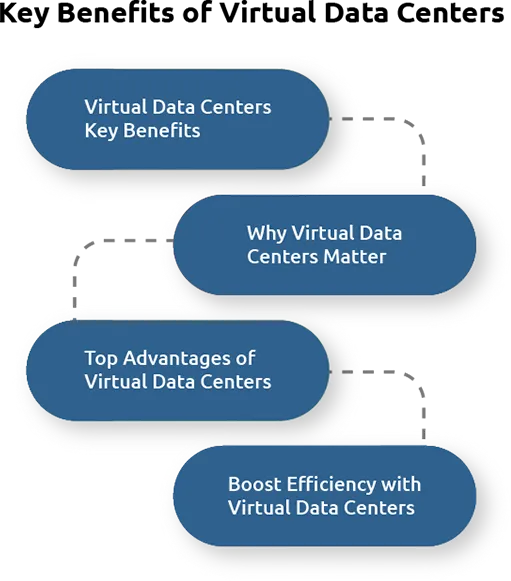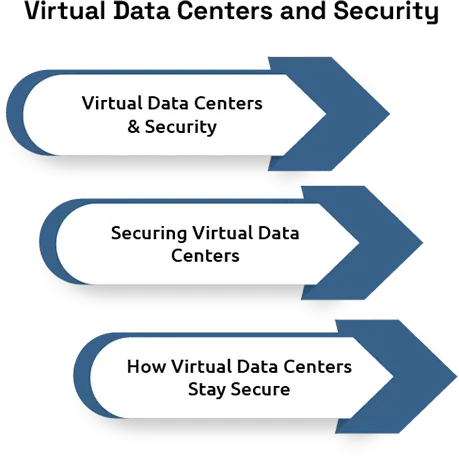A virtual data center is a contemporary model of IT infrastructure that enables organizations to consume services from a cloud-based offering rather than maintaining on-premises hardware and servers. Top data center companies pay a subscription fee per use for computing resources such as storage, network, and computing from cloud providers which reduces upfront capital expense and infrastructure management related to physical data centers, to have the flexibility to quickly scale IT resources in an on-demand model.
This significant departure from traditional IT infrastructure models has introduced VDC as an essential building block for any organization’s digital transformation effort, allowing them to scale their IT resources as needed to improve security and save costs. Supporting vDCS helps organizations increase operational efficiencies in IT. Billing is based on usage, and vDCS organizations do not need to procure and manage hardware within their data center. Organizations are now able to spin up and spin down infrastructure resources instantaneously based on increasing or decreasing demand. In addition, VDCS requires fewer infrastructure resources because multiple deployment methods allow the organization to select its public, private, or hybrid cloud deployment method. This change reflects the demand for competitive VDC within the rapidly evolving marketplace.
Key Benefits of Virtual Data Centers
Virtual data centers bring several advantages to businesses. Saving money is a big advantage. Traditional data centers need a lot of money for hardware, networking, space, and maintenance. Instead, virtual data center companies save money by offering a cloud-based service where businesses rent resources only when needed. This not only minimizes initial capital expenditure but also eliminates the need for physical space and complex maintenance cutting operational costs.
Another important advantage of virtual data centers is their ability to scale. As mentioned, Traditional data centers have to proactively predict and purchase as much capacity as needed for customer requests which can waste resources and cause a shortage when demand ramps up. Virtual data centers take this worry out of the equation by being able to easily scale up and down according to demand. When business needs increase, they can scale that up or down depending on pricing. Or, if a business needs some cutting-edge redundancy, it can reduce its overhead and increase its capacity without having to downsize.

How Virtual Data Centers Work
The virtual data centers use new technology that turns physical hardware into virtual resources, allowing multiple virtual systems to get permission to run on one server. Leading data center companies can run multiple virtual machines on one physical server, making operations more efficient and using resources better. The Hyper Controller for Virtual Machines is a crucial application that facilitates the simultaneous operation of several virtual machines on a single machine without disrupting each other’s hardware. Virtualization optimizes resource utilization and aids businesses in operating efficiently by permitting workloads to shift across virtual systems with minimal interruption.
A major benefit of virtual data centers is the easy adjustment and management of resources as needed. Under this model, businesses can scale their infrastructure dynamically based on immediate needs, whether more storage, additional computing power, or both. In contrast to traditional physical data centers, where upgrades and maintenance take time and money, virtually provisioned data centers enable resources to be provisioned almost instantaneously so that businesses become agile entities able to respond more readily to market demands.
.
Virtual Data Centers and Security
Security is a primary concern when moving to virtual data centers. With the escalation of cyber threats, prominent data center firms must ensure their information remains protected in the cloud. A significant advantage of virtual data centers is their enhanced security attributes. These consist of unified security oversight, where protection measures are enforced across all elements of the infrastructure from a singular interface. This makes it easier to monitor, track, and enforce security measures with firewalls, encryption, and access controls.
Also, online data hubs get help from cloud firms, which have skilled safety squads that keep watch for flaws all the time. While companies still need to use their safety steps, cloud firms often provide round-the-clock watching, automatic backups, and recovery plans, making sure that info stays safe and easy to reach. Ways of changing text both for moving data and keeping it further hide important details from people not allowed to see it, giving an added level of protection. By taking advantage of these united safety actions, firms can keep rules in line with business laws and guard their info from changing dangers.

Real-World Applications of Virtual Data Centers
Virtual data centers are being adopted across multiple industries for their efficiency and cost-effectiveness. For including, in the financial sector, Big Tech Data Center companies, including J.P. Morgan, are transitioning to virtual data centers to minimize their hardware footprints and improve operational efficiency. By moving to a virtual environment, financial organizations can make sure they have the scalability required to handle fluctuating workload,s such as during tax season or economic crises. They also gain enhanced security features, which make it difficult to protect sensitive financial data.
The healthcare sector is joining the bandwagon of virtual data centers to create modern IT environments. Increasing telemedicine and EHR applications in healthcare necessitate flexible, scalable systems that can handle massive patient data volumes and store such data securely. In other words, virtual data centers will anchor these crusades while enforcing regulatory compliance in the end. Virtual solutions will enable improved patient care, lower costs, and more security for sensitive information in health organizations.
Challenges in Implementing Virtual Data Centers
Virtual data centers give great advantages but businesses encounter challenges when adopting them. One major challenge is implementing virtual data centers with existing IT infrastructure. Data center businesses often rely on legacy systems that may not be fully compatible with cloud-based environments. Migrating data and workloads to a virtual environment can be complex and may require additional staff training. Another challenge is managing complexity.
As organizations grow and add more virtualized resources, the number of virtual machines and data traffic can increase exponentially. Managing complexity requires a strong monitoring tool, automation, and experienced IT staff. Centralized management tools can help reduce complexity when handling multiple virtualized environments and improve overall performance.








